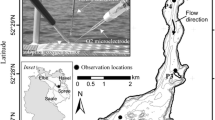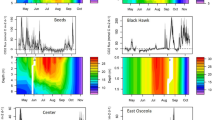Abstract
Patterns of estimates of oxygen flux (J) across the air–water interface of hypereutrophic Onondaga Lake, NY, U.S.A., are characterized for time scales ranging from diel to seasonal for an 8-month period. The analysis is supported by a high frequency (most often hourly) monitoring program, conducted with a robotic buoy, that included measurements of dissolved oxygen (DO), temperature, and fluorometric chlorophyll a in the lake's surface waters, vertical profiles of DO through the epilimnion, and wind speed and solar radiance. The magnitude and direction of J is demonstrated to vary dramatically at diel, day-to-day, and seasonal time scales. Thus, large errors in estimates of J may result from extrapolating flux calculations made from short-term data to longer time periods. The variations in J were driven by variations in metabolic activity and meteorology, and were mediated by departures from equilibrium DO concentrations and wind-driven turbulence. Extended periods of high J values are shown to coincide with intervals of large departures from equilibrium DO concentrations, but day-to-day differences are driven mostly by variations in wind. A distinct diel pattern of J estimates is manifested for average conditions, with substantially higher J values during daylight hours. This pattern reflects the common diel patterns of the drivers of both higher DO oversaturation and wind speed over those hours. It is demonstrated that the magnitude of J is substantial relative to net changes in the epilimnetic DO pool, and thus must be accommodated accurately in estimates of primary production and community respiration that are to be based on diel monitoring of DO in the water columns of productive lakes.
Similar content being viewed by others
References
APHA (American Public Health Association), 1992. Standard Methods for the Examination ofWater andWastewater, 18th edn. American Public Health Association, Washington, DC.
Addess, J. M. & S.W. Effler, 1996. Summer methane fluxes and fall oxygen resources of Onondaga Lake, New York. Lake Reserv. Manage. 12: 91–101.
Auer, M. T. & S. W. Effler, 1989. Variability in photosynthesis: impact on DO models. J. Environ. Engrg. Div. ASCE 115: 944–963.
Auer, M. T., M. L. Storey, S. W. Effler & N. A. Auer, 1990. Zooplankton impacts on chlorophyll and transparency in Onondaga Lake, NY. U.S.A. Hydrobiologia/Dev 200/201: 603–617.
Banks, R. B. & F. F. Herrera, 1977. Effect of wind and rain on surface reaeration. J. Environ. Engrg. Div. ASCE 103: 489–504.
Bella, D. A., 1970. Dissolved oxygen variations in stratified lakes. J. Sanitary Engrg. Div., ASCE 96: 1129–1146.
Bowie, G. L., W. B. Milles, D. B. Porcella, C. L. Campbell, J. R. Pagenkopf, G. L. Rupp, K. M. Johnson, P. W. Chan, S. A. Gherini & C. E. Chamberlin, 1985. Rates, Constants, and Kinetic Formulations in Surface Water Quality Modeling (2nd Edition). EPA/600/3-85/040, United States Environmental Protection Agency, Environmental Research Laboratory, Athens, GA 30613.
Bretts, K. S., 1998. Technology Update – All-weather water quality monitor. Environ. Sci. Technol. 32: 85.
Broecker, W. S., T.-H. Peng, G. Mathieu, R. H. Hesslein & T. Torgersen, 1980. Gas exchange rate measurements in natural systems. Radiocarbon 22: 676–683.
Chapra, S. C., 1997. Surface Water-Quality Modeling. McGraw-Hill, New York: 844 pp.
Cole, G. A., 1994. Textbook of Limnology. Waveland Press, Prospect Heights, IL.: 412 pp.
Cole, T. M. & S. A. Wells, 2000. CE-QUAL-W2: A Two-Dimensional, Laterally Averaged, Hydrodynamic and Water Quality Model, Version 3.0. U.S. Army Corps of Engineers, Washington, DC.
Connors, S. D., M. T. Auer & S.W. Effler, 1996. Phosphorus pools, alkaline phosphatase activity, and phosphorus limitation in hypereutrophic Onondaga Lake, NY. Lake Reserv. Manage. 12: 47–57.
Daniil, E. I. & J. S. Gulliver, 1991. Influence of waves on air–water gas transfer. J. Environ. Engrg. Div. ASCE 117: 522–540.
Doerr, S. M., S. W. Effler & E. M. Owens, 1996. Forecasting impacts of a hypolimnetic wastewater discharge on lake water quality. Lake Reserv. Manage. 12: 207–217.
Effler, S. W., 1996. Limnological and Engineering Analysis of a Polluted Urban Lake. Prelude to Environmental Management of Onondaga Lake, New York. Springer-Verlag, New York, NY.
Effler, S. W., C. M. Brooks & K. A. Whitehead, 1996. Domestic waste inputs of nitrogen and phosphorus to Onondaga Lake, and water quality implications. Lake Reserv. Manage. 12: 127–140.
Effler, S. W., J. P. Hassett, M. T. Auer & N. A. Johnson, 1988. Depletion of epilimnetic oxygen, and accumulation of hydrogen sulfide in the hypolimnion of Onondaga Lake, NY, U.S.A. Water Air Soil Pollut. 39: 59–74.
Effler, S.W., D. M. O'Donnell & C. J. Owen, 2002. America's most polluted lake: Monitoring rehabilitation with computer-driven robots. J. Urban Technol. 9: 21–44.
Gelda, R. K. & M. T. Auer, 1996. Development and testing of a dissolved oxygen model for a hypereutrophic lake. Lake Reserv. Manage. 12: 165–179.
Gelda, R. K., M. T. Auer, S. W. Effler, S. C. Chapra & M. L. Storey, 1996. Determination of reaeration coefficients: A whole lake approach. J. Environ. Engrg. Div. ASCE 122: 269–275.
Gelda, R. K., S. W. Effler & S. M. O'Donnell, 2001. Probabilistic model of ammonia and toxicity status for urban lake. J. Water Res. Plan. Manage. 127: 337–347.
Lampert, W., W. Fleckner, H. Rai & B. E. Taylor, 1986. Phytoplankton control by grazing zooplankton: a study on the spring clear-water phase. Limnol. Oceanogr. 31: 478–490.
Lingeman, R. & S. Vermij, 1980. Estimation of primary productivity in aquatic systems using free oxygen measurements. Wat. Resour. Bull. 16: 745–748.
Madsen, J. D., J. A. Bloomfield, J. W. Sutherland, L. W. Eichler & C. W. Boylen, 1996. The aquatic macrophyte community of Onondaga Lake: field survey and plant growth bioassays of lake sediments. Lake Reserv. Manage. 12: 73–79.
Martin, J. L. & S. C. McCutcheon, 1999. Hydrodynamics and Transport for Water Quality Modeling. Lewis Publishers, Boca Raton, FL: 794 pp.
Matthews, D. A., S. W. Effler, C. M. Matthews (Brooks), C. A. Siegfried & M. E. Spada, 2001. Responses to early stages of rehabilitation: Onondaga Lake, NY. Wat. Environ. Res. 73: 691–703.
Munn, R. E., 1976. Atmospheric transport and diffusion on the regional scale. J. Great Lakes Res. 2: 1–20.
O'Connor, D. J., 1983. Wind effects on gas-liquid transfer coeffi-cients. J. Environ. Engrg. Div. ASCE 109: 731–752.
Owens, E. M. & S. W. Effler, 1989. Changes in stratification in Onondaga Lake, NY. Wat. Resour. Bull. 25: 587–597.
Perkins, M. G. & S. W. Effler, 1996. Optical characteristics of Onondaga Lake 1968–1990. Lake Reserv. Manage. 12: 103–113.
Rowell, C., 1996. Paleolimnology of Onondaga Lake: the history of anthropogenic impacts on lake water quality. Lake Reserv. Manage. 12: 35–45.
Sellers, P., R. H. Hesslein & C. A. Kelly, 1995. Continuous measurement of CO2 for estimation of air–water fluxes in lakes: an in situ technique. Limnol. Oceanogr. 40: 575–581.
Siegfried, C. A., N. A. Auer & S. W. Effler, 1996. Changes in zooplankton of Onondaga Lake: causes and implications. Lake Reserv. Manage. 12: 59–71.
Stauffer, R. E., 1980. Windpower time series above a temperate lake. Limnol. Oceanogr. 25: 513–528.
Tango, P. J. & N. H. Ringler, 1996. The role of pollution and external refugia in structuring the Onondaga Lake fish community. Lake Reserv. Manage. 12: 81–90.
Thomann, R. V. & J. A. Mueller, 1987. Principles of Surface Water Quality Modeling and Control. Harper & Row Publishers, NY.
Vollenweider, R. A., 1974. A Manual on Methods for Measuring Primary Production in Aquatic Environments. 2nd edition. IBP Handbook No. 12. Blackwell Scientific, Oxford, U.K.
Wanninkhof, R., J. R. Leduidl & J. Crusius, 1991. Gas transfer velocities on lakes measured with sulfur hexafluoride. In Wilhelms, S. C. & J. S. Gulliver (eds), AirWaterMass Transfer. Symposium volume of the second international conference on gas transfer at water surfaces, Minneapolis, MN: 441–458.
Wetzel, R. G., 2001. Limnology: Lake and Reservoir Ecosystems. Academic Press, New York.
Wu, J., 1971. Anemometer height and Froude scaling of wind stress. J. Waterways, Harbors, Coastal Engrg. Div. ASCE 97: 131–137.
Author information
Authors and Affiliations
Corresponding author
Rights and permissions
About this article
Cite this article
Gelda, R.K., Effler, S.W. Estimating oxygen exchange across the air–water interface of a hypereutrophic lake. Hydrobiologia 487, 243–254 (2002). https://doi.org/10.1023/A:1022994217578
Issue Date:
DOI: https://doi.org/10.1023/A:1022994217578




